Make the Switch to Plastic Pallets

If you run a warehouse or distribution business that handles food or pharmaceuticals, then you know that safety, cleanliness and sanitation are your top priorities. Without a clean operation, you risk contaminating your products, which renders them unsaleable. This drives up your inventory write-offs and eats away at your bottom line. One major culprit that puts your sensitive products at risk is the wood pallets used to ship and move your loads.
Wood, by its very nature, can become a breeding ground for mold, rot, and insects. And in pallet form, wood is an unintentional transport mechanism for contaminants. Wood is also biodegradable and will break down and wear out over time. You can significantly increase the cleanliness of your supply chain and the sustainability of your pallets by making the transition from wood to plastic pallets. Plastic pallets are more sustainable and sanitary than their wooden counterparts and are designed to handle heavy loads with ease. Plastic is also easier to clean and sterilize.
Once you’ve decided to make the switch to plastic pallets, you still should consider the various types, capacities and styles available in plastic pallets. You’ll also need to choose a supplier who you can trust when you make this long-term investment. Cherry’s Industrial is here to help you decide on the right plastic pallets for your business needs and guide you through this important transition process.
Contact us online
Give us a call at 800-350-0011
Benefits of Plastic Pallets
Compared to other materials, plastic pallets are ideal for almost every industrial application — especially in industries that have rigorous sterilization and hygiene standards like food or pharmaceutical businesses. You should consider switching to plastic pallets because they are:
- Durable: Plastic pallets are made out of high-quality materials, including high-density polyethylene (HDPE) and polypropylene (PP), making them non-porous and sturdy. This means plastic pallets can support heavy weight with ease and are resistant to chemicals, odors and stains. If properly handled and maintained, plastic pallets will withstand several years of constant use, offering you a more substantial return on investment than many other options.
- Sanitary: The FDA Food Safety Modernization Act (FSMA) issued a final ruling on the Sanitary Transportation of Human and Animal Food rule, which states that precautions must be taken during the shipping and handling process to eliminate any chance of cross-contamination between shipments. This includes pallets constructed out of easy-to-clean materials. In these unpredictable times, it is more important than ever to choose sanitary shipping methods whenever possible. Plastic pallets can withstand high-temperature washing, drying and sterilization without warping or growing mold. Most plastic pallets are designed in a single-mold process, which means there are no additional pieces, corners or fittings — like nails or planks — that could hide dirt or debris. Plastic pallets can be easily wiped down in between shipments, and you can use an industrial pallet washing and drying system to ensure a thorough, disinfecting clean before new shipments.
- Safe: Wooden pallets can chip, crack, splinter and leave a trail of slippery sawdust wherever they travel. As they wear down over time, they can also develop rough or sharp edges. These can put workers and products at risk. Plastic pallets are smooth, uniform and safer to handle.
- Versatile: Finally, there are several plastic pallet dimensions and variations to choose from, including stackable, edge rackable, nestable, solid deck, export and drum pallets. Most plastic pallets are also recyclable, making them a sustainable choice.
Why Make the Switch to Plastic Pallets?
Plastic pallets have become a popular business investment over the past several years. Many warehouse managers and operations specialists have come to realize the vast advantages and benefits that plastic pallets have over wood pallets. They recognize that changing from wood to plastic pallets is the smart, sustainable choice.

Knowledgeable food processing companies, contract manufacturers, food packaging businesses and pharmaceutical distributors understand that switching to plastic pallets is the wise choice for several reasons. These reasons are virtually endless when you think about it. But here are a few important reasons why many companies are transitioning to plastic pallets and phasing out old, outdated wooden ones:
- Ensuring all government health and sanitation regulations are met.
- Investing in durable and long-lasting pallets.
- Preventing rot, mold and debris from entering the facility.
- Addressing loss prevention by eliminating the risk of product damage and contamination.
- Maintaining a safe workplace by using smooth, lightweight and clean pallets.
Of course, not all plastic pallets are created equal. They’re each designed with specific features, dimensions and capacities that serve different business functions. Before you purchase a new inventory of plastic pallets, you need to understand your plastic pallet criteria.
Identify What You Need in a Plastic Pallet
There are several factors to consider when switching over to plastic pallets. You need to look at your business needs and choose the pallet type that will meet these requirements. The most efficient way to assess your needs is to create a plastic pallet criteria scorecard. This scorecard takes stock of the different specs and features of each plastic pallet type and compares them so you can see which pallet is best suited for your business needs.
To start your scorecard, rate each pallet option on a scale from 1-10 in each of the following seven criteria areas:
- Durability and longevity
- Value and cost-effectiveness
- Hygiene and cleanliness
- Consistency in size and weight
- Racking strength
- Fireproof rating (if required)
- Compatibility with existing warehouse machinery and equipment
While rating each pallet type against these criteria, you may want to give each factor its weight. For example, if durability has been a common problem in the past and you’ve lost product to weak pallets, then the longevity of the new pallet should hold greater weight than, for example, a low price. You’ll end up having to purchase fewer pallets that make highly durable pallets more valuable to your business.
If you’re in the food handling or pharmaceutical business, then you know there is no wiggle room in the hygiene category. There are certain cleanliness standards your facility needs to meet, so you cannot compromise on pallet sanitation. Therefore, the cleanliness and hygiene factor carries a higher weight than other factors.
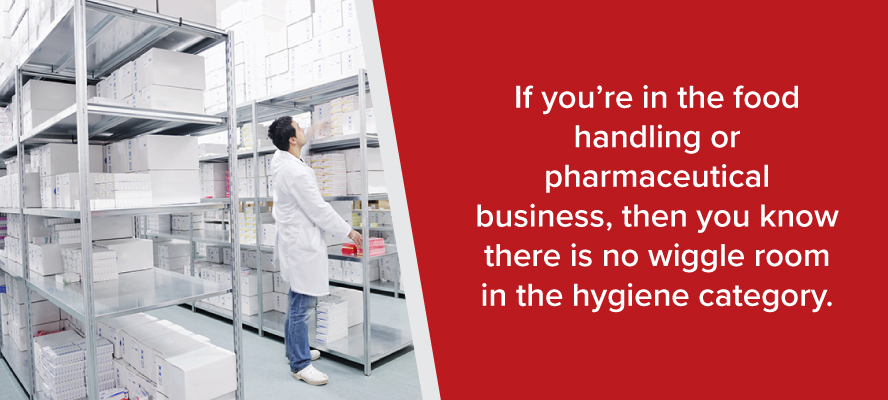
When you identify what you need in a plastic pallet, be sure to prioritize your criteria based on your unique business needs. Once you’ve got those factors figured out, you can then move on to sourcing the pallet you need from the right supplier.
Contact us online
Give us a call at 800-350-0011
What Are You Looking for in a Plastic Pallet?
Knowing you need to switch over to plastic pallets is one thing. It’s a whole different decision to find the right plastic pallet brand for you. Suppliers need to provide you with several options that meet your criteria. This will help you choose the right line of plastic pallets to implement in your facility. Excellent suppliers carry a wide variety of plastic pallets, including ones that are durable, hygienic and the right size and weight for your existing load standards.
The right supplier, for example, provides pallets that go beyond just the standard 48-inch by 40-inch dimensions. Within Cherry’s selection of pallets, you will find a vast selection of dimensions, including what we call the “oddball” size pallets with dimensions such as 48-inch by 60-inch or 48-inch by 72-inch. Custom size pallets are also available. When it is all said and done, the best plastic pallet supplier provides quality equipment and solutions while also nurturing fruitful and long-term business relationships.
When it comes to finding the right pallet for your company Cherry’s Industrial Equipment is here to serve. We’re experts in helping our industrial customers find the right plastic pallets for their business needs. Our plastic pallets are made to meet government regulations and ensure high standards of cleanliness and hygiene in your facility.
Our brand selection of pallets, whether it be Craemer, Stratis, Polymer Solutions or ORBIS, are built to last. ORBIS brand plastic pallets are constructed with structural foam plastic made from high-density polyethylene, which is 100% recyclable. Monoflo, Polymer Solutions and Craemer brand plastic pallets are constructed through a superior mold-casting process called polypropylene injection molding.
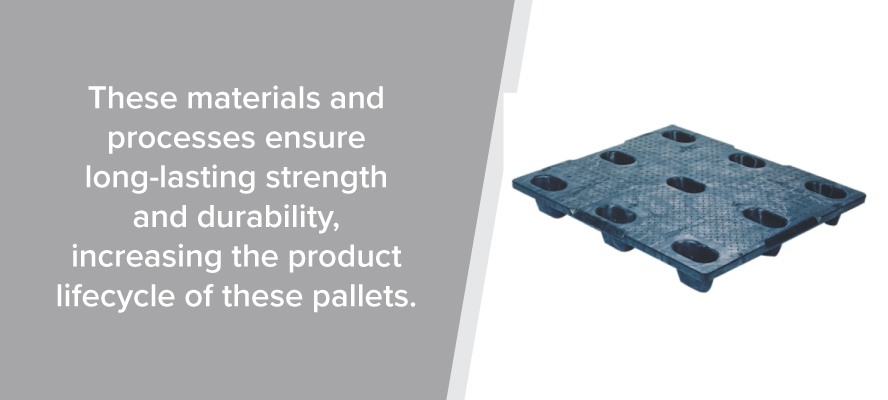
These materials and processes ensure long-lasting strength and durability, increasing the product lifecycle of these pallets. A longer product lifecycle means a greater return on your investment.
Our plastic pallets also offer versatility with stacking, racking and nesting capabilities. We’ve got a great selection of plastic pallets that can help bring your business up-to-date with modern industry standards.
Test and Evaluate Your Plastic Pallets
As part of making the switch to plastic pallets, it’s important to implement a testing and evaluation phase. After you’ve identified your critical plastic pallet criteria and found the right plastic pallet supplier for you, you can then test out some plastic pallets to make sure they work in your facility.
You want to complete this testing and evaluating stage before you place a bulk order of plastic pallets to replace your wood ones. This prevents the risk of ordering the wrong pallets and the headache that comes with having to return and order new ones. It also gives you an opportunity to test out different pallets and maybe realize there are some criteria you missed or didn’t think to consider.
Once you’ve narrowed down your plastic pallet options based on racking strength, durability and construction materials, you’re then ready to order your chosen pallets for testing and evaluating. Here are some tips on how to implement the testing and evaluation stage of changing from wood to plastic pallets:
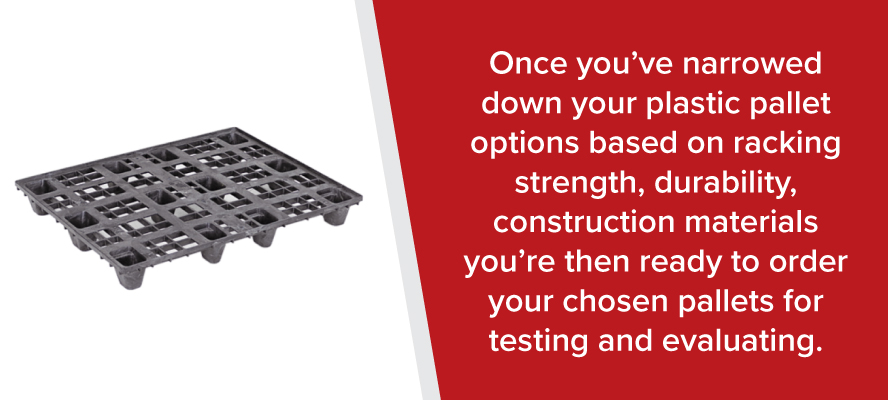
- Testing time period: Consider how long it will take to test and evaluate your plastic pallet choice thoroughly. You may need to send them through several full completions of your supply chain to get a good idea of how they stand up to your specific requirements.
- Sample size: Consider how many plastic pallets you want to order to complete this testing period. Consider how many pallets you’ll need to fulfill several full shipments. Consider different capacities and sizes you want to add to your testing phase. Will you test out several pallets for several different load capacities? Consider different shipment scenarios before you order your plastic pallet samples.
- Measuring your critical criteria: Once you’ve got your sample plastic pallets into rotation, measure them against each of the above-mentioned criteria. Once these pallets are in action, consider their durability, strength and compatibility with your existing machinery.
- Evaluate your results: After you’ve implemented your plastic pallet samples and rated them based on your criteria, you can now make your final evaluation. Did these pallets realistically meet your needs and expectations? In what areas can you find improvements? Cherry’s Industrial equipment specialists are here to help you consider all your plastic pallet options and needs.
Determine the Total Cost of Conversion
As part of the process of converting from wood to plastic pallets, it’s important to get clear on the total cost that this switch will incur. There are many costs associated with switching out your wood pallets and going with plastic, not the least of which is the cost of the pallet itself.
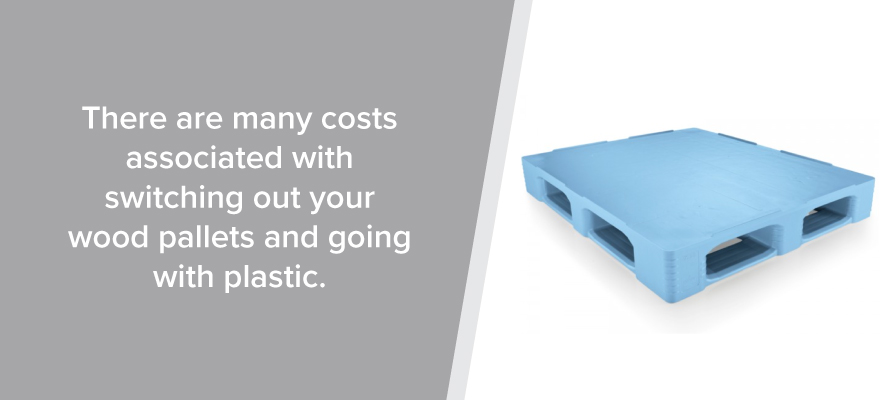
There are other hidden or overlooked costs that you may not think of initially. At Cherry’s Industrial Equipment, we pride ourselves on supporting our customers in their conversion to plastic pallets. We have years of experience in helping industrial businesses convert to modern plastic pallets, and we know what this process entails.
Here’s a look at the different items involved in calculating the total cost of switching to plastic pallets from wood:
- Pallet cost: The total cost of your initial pallet order is the most obvious cost associated with your transition to plastic pallets.
- Facility upgrades: Unlike wood pallets, plastic pallets have specific cleaning and care requirements. This means you’ll need to provide the necessary investment and accommodations for the pallet-cleaning station.
- Material handling equipment: When transitioning your inventory loads from wood to plastic pallets, you’ll benefit from pallet inverters. These convenient machines seamlessly transfer loads from wood pallets to plastic pallets without the need to restack inventory using manual labor. This cuts back on potential product loss as well as worker injuries. Other new equipment investments include pallet washers and dryers, pallet retrievers and stretch wrapping machines. Cherry’s Industrial is your one-stop supplier for all the equipment you need to make the transition to plastic pallets.
- Storage upgrades: When you make the switch to plastic pallets, your storage requirements for housing your plastic pallets can change. For example, you may need to add new pallets supports or wire decking to your pallet racking to provide additional load support for your new pallets.
- Operations costs: When transitioning to plastic pallets, there are operational costs to consider. These costs include the additional labor tasked specifically to make the switch, as well as provisions for theft and damage control. You want to mitigate product loss as much as possible during the transition. You may need to budget ahead for potential shrinkage.
- Wood pallet disposal: After your transition from wood to plastic pallets, you’ll need to dispose of your old pallets. You’ll likely need to hire a junk removal company to take away your old pallets. Or you may have a local recycling exchange program that will charge a fee for wood pallet recycling.
When you factor in all these aspects, you can calculate the total cost associated with making the switch to plastic pallets. There will be other costs to consider as well, depending on your internal protocols. Don’t forget to lay out a full transition plan ahead of time to account for these.
Place Your Order for New Plastic Pallets
You’ve considered all your pallet needs, sourced Cherry’s Industrial as your plastic pallet supplier and tested out your new pallets in your distribution chain. You’ve budgeted for the total cost of your transition to plastic pallets, and you’re convinced about the return on investment that these hygienic and durable pallets provide. Now it’s time to place your plastic pallet order.
Cherry’s Industrial’s knowledgeable equipment specialists are here to help you with this important step. You can reach us at 1-800-350-0011.
Be Informed on Safety Issues
Changing to plastic pallets is a big move. One of the often-overlooked aspects of switching over to plastic is the increased fire safety risk your facility may be incurring. As a savvy warehouse operator, you know that being on the up and up when it comes to fire regulations and insurance requirements is critical. Depending on how many new plastic pallets you’re bringing on board, you may be subject to a change in your insurance policy.
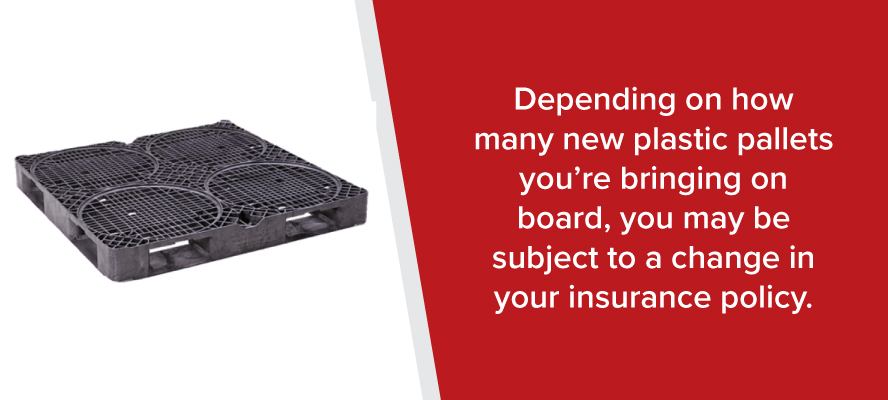
If you’re bringing on thousands of new plastic pallets, be sure to discuss the following topics with your local fire marshals and your insurance provider:
- M and UL standards approval
- Idle storage requirements
- Burn rates of your plastic pallets
- Other approvals like USDA or fire ratings
Thinking ahead and planning for these safety issues will ensure you’re compliant with fire safety regulations and covered by your insurance provider, and help you maintain a safety-oriented organization.
Train Your Staff on Using Plastic Pallets and Related Equipment
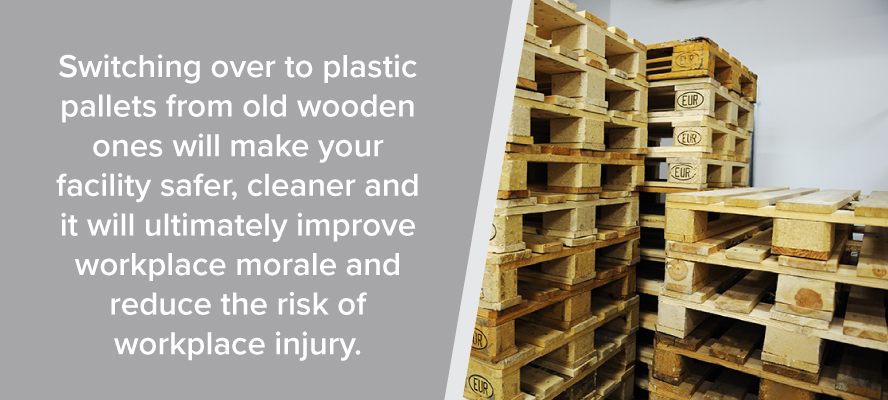
Switching over to plastic pallets from old wooden ones is an exciting step forward for your company. It will make your facility safer, cleaner and it will ultimately improve workplace morale and reduce the risk of workplace injury. It improves your bottom line as well, which translates to higher profitability and, ultimately, greater career opportunities for your valued staff.
Because your workers are the most integral part of your organization, it’s vital to involve and immerse them in the transition process. Your operations team will need to set out a step-by-step procedure of how this transition will occur. Communicate with your staff how this process will unfold and what your expectations for them. Set forth realistic expectations about the timeframe as well as their exact duty requirements.
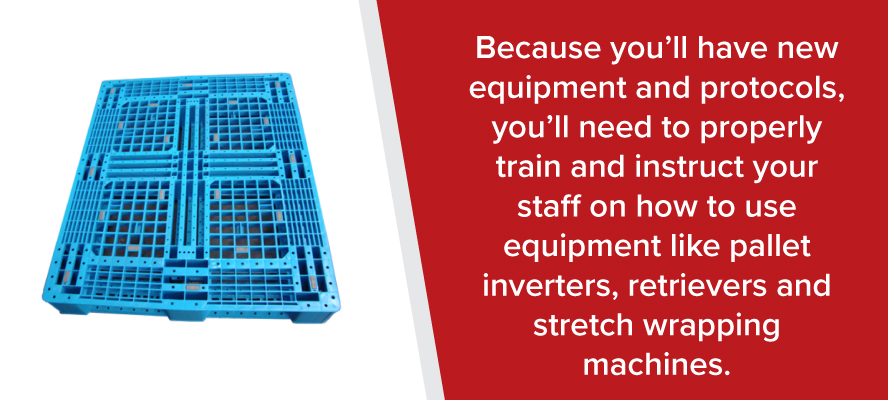
Because you’ll have new equipment and protocols, you’ll need to properly train and instruct your staff on how to use equipment like pallet inverters, retrievers and stretch wrapping machines.
It’s also important to think ahead to how your staff members’ day-to-day roles will change once you implement the new plastic pallets. For example, proper washing and sanitizing will now be a mainstay in your operations. That means that staff will have this new task to take on. Make sure they’re fully trained on how to load, move, stack, wash and care for your new business investment. Champion your team and give them ownership over their role in this transition. Ultimately, you must reinforce the value of changing to plastic pallets and why it’s a necessary business decision.
Contact us online
Give us a call at 800-350-0011
You’re Ready — It’s Time to Make the Switch to Plastic Pallets!
Before your pallets arrive and you physically make the switch to plastic pallets, be sure to have an operation plan in place. Planning for how you’ll transition your loads over to plastic pallets is important. You need to account for each step. You also need a contingency plan that considers the “what ifs” should anything derail. One of the best ways to plan for a smooth transition is to use a project management tool that involves a work breakdown structure. This will help you work backward to consider every aspect of this transition.
Here are some of the necessary steps to consider so that your transition goes smoothly:
- Switching over your inventory: Think ahead to how much inventory is switching over. Divide up your inventory into priorities to decide which loads will switch first.
- Receiving your shipment: Know what time you’ll be receiving your pallet shipment. Make sure you have a designated receiving and storing area for your plastic pallets.
- Unpacking your shipment: When will you unpack your shipment? Who will be in charge of unpacking the pallets? Think about what to do with your pallets immediately as they cannot take up floor space for long.
- Transferring loads: You’ll need to establish a load transferring workstation and coordinate logistics. Decide how many people will be in charge of load transfers and where they’ll conduct this work.
- Moving and storing transferred loads: As the loads transfer, your workers will need to move the newly loaded plastic pallets back to their storage locations. Make sure you’ve upgraded your pallet racking before this step.
- Removing old pallets: As your staff transfers the loads from the old pallets to the new ones, you’ll also need a solution for what to do with the empty wood pallets and where to put them. Remove as many wood pallets at once to increase efficiency. Have a designated area to store your empty wood pallets until they’re removed out of the facility entirely.
Monitor the Impact
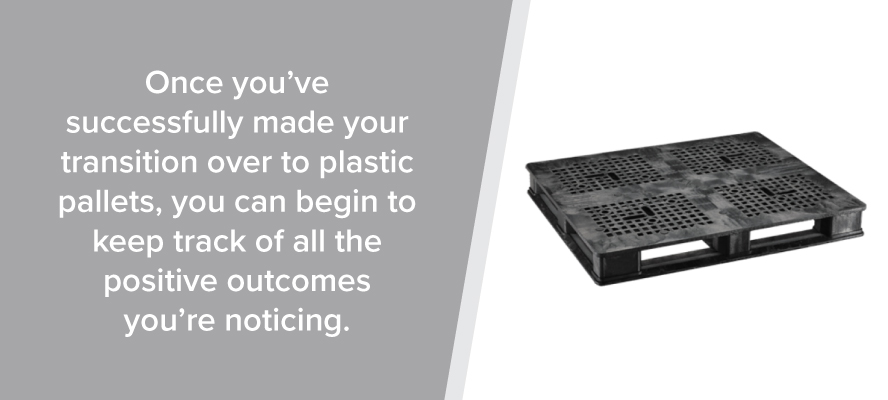
Once you’ve successfully made your transition over to plastic pallets, you can begin to keep track of all the positive outcomes you’re noticing. Be sure to monitor specific metrics such as productivity and shrink. By measuring these important business figures, you can see a tangible return on your investment. You can compare your updated key performance indicators to when you used wooden pallets.
As you adjust to your new plastic pallets, you can continue to monitor your results and see the vast improvements and impact this transition has had in all areas of your business. Be sure to ask for feedback from your staff about what they think of the new pallets. They’ll also be a resource for suggesting process improvements, which you can implement as you go.
Let Cherry’s Industrial Equipment Help You Transition to Plastic Pallets
Converting from wood to plastic pallets isn’t just smart business sense. It’s a must for any business operating in food handling. Plastic pallets keep your products safe and contaminant-free. They’re also more durable and longer-lasting than wood pallets. Deciding to switch to plastic pallets is easy. The challenging part is the steps involved in ensuring a smooth transition. Thankfully, the information provided here can help you navigate these changes.
With so much to know about making the switch to plastic pallets from wood, it’s essential to work with the right knowledgeable and experienced supplier to help you with the transition. Cherry’s Industrial is that supplier. We carry durable, hygienic and cost-effective plastic pallets that will improve overall efficiency and cleanliness in your facility. We also provide other necessary pallet-handling equipment to build upon this transition. This includes our PSR and VBED pallet retriever models, as well as pallet inverters and stretch wrappers. Don’t forget that you also need a new pallet cleaning system, which Cherry’s Industrial can provide as well through our pallet washing and drying solutions.
Contact Cherry’s Industrial Equipment today for more information on making the transition to plastic pallets or for help placing your order.